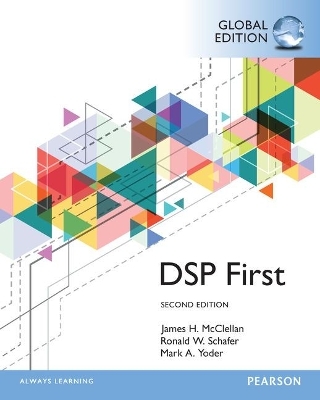
Digital Signal Processing First, Global Edition
Pearson Education Limited (Verlag)
978-1-292-11386-9 (ISBN)
DSP First and its accompanying digital assets are the result of more than 20 years of work that originated from, and was guided by, the premise that signal processing is the best starting point for the study of electrical and computer engineering. The "DSP First" approach introduces the use of mathematics as the language for thinking about engineering problems, lays the groundwork for subsequent courses, and gives students hands-on experiences with MATLAB.
The 2nd Edition features three new chapters on the Fourier Series, Discrete-Time Fourier Transform, and the The Discrete Fourier Transform as well as updated labs, visual demos, an update to the existing chapters, and hundreds of new homework problems and solutions.
Introduction
1-1 Mathematical Representation of Signals
1-2 Mathematical Representation of Systems
1-3 Systems as Building Blocks
1-4 The Next Step
Sinusoids
2-1 Tuning Fork Experiment
2-2 Review of Sine and Cosine Functions
2-3 Sinusoidal Signals
2-3.1 Relation of Frequency to Period
2-3.2 Phase and Time Shift
2-4 Sampling and Plotting Sinusoids
2-5 Complex Exponentials and Phasors
2-5.1 Review of Complex Numbers
2-5.2 Complex Exponential Signals
2-5.3 The Rotating Phasor Interpretation
2-5.4 Inverse Euler Formulas Phasor Addition
2-6 Phasor Addition
2-6.1 Addition of Complex Numbers
2-6.2 Phasor Addition Rule
2-6.3 Phasor Addition Rule: Example
2-6.4 MATLAB Demo of Phasors
2-6.5 Summary of the Phasor Addition Rule Physics of the Tuning Fork
2-7.1 Equations from Laws of Physics
2-7.2 General Solution to the Differential Equation
2-7.3 Listening to Tones
2-8 Time Signals: More Than Formulas
Summary and Links
Problems
Spectrum Representation
3-1 The Spectrum of a Sum of Sinusoids
3-1.1 Notation Change
3-1.2 Graphical Plot of the Spectrum
3-1.3 Analysis vs. Synthesis
Sinusoidal Amplitude Modulation
3-2.1 Multiplication of Sinusoids
3-2.2 Beat Note Waveform
3-2.3 Amplitude Modulation
3-2.4 AM Spectrum
3-2.5 The Concept of Bandwidth
Operations on the Spectrum
3-3.1 Scaling or Adding a Constant
3-3.2 Adding Signals
3-3.3 Time-Shifting x.t/ Multiplies ak by a Complex Exponential
3-3.4 Differentiating x.t/ Multiplies ak by .j 2nfk/
3-3.5 Frequency Shifting
Periodic Waveforms
3-4.1 Synthetic Vowel
3-4.3 Example of a Non-periodic Signal
Fourier Series
3-5.1 Fourier Series: Analysis
3-5.2 Analysis of a Full-Wave Rectified Sine Wave
3-5.3 Spectrum of the FWRS Fourier Series
3-5.3.1 DC Value of Fourier Series
3-5.3.2 Finite Synthesis of a Full-Wave Rectified Sine
Time–Frequency Spectrum
3-6.1 Stepped Frequency
3-6.2 Spectrogram Analysis
Frequency Modulation: Chirp Signals
3-7.1 Chirp or Linearly Swept Frequency
3-7.2 A Closer Look at Instantaneous Frequency
Summary and Links
Problems
Fourier Series
Fourier Series Derivation
4-1.1 Fourier Integral Derivation
Examples of Fourier Analysis
4-2.1 The Pulse Wave
4-2.1.1 Spectrum of a Pulse Wave
4-2.1.2 Finite Synthesis of a Pulse Wave
4-2.2 Triangle Wave
4-2.2.1 Spectrum of a Triangle Wave
4-2.2.2 Finite Synthesis of a Triangle Wave
4-2.3 Half-Wave Rectified Sine
4-2.3.1 Finite Synthesis of a Half-Wave Rectified Sine
Operations on Fourier Series
4-3.1 Scaling or Adding a Constant
4-3.2 Adding Signals
4-3.3 Time-Scaling
4-3.4 Time-Shifting x.t/ Multiplies ak by a Complex Exponential
4-3.5 Differentiating x.t/ Multiplies ak by .j!0k/
4-3.6 Multiply x.t/ by Sinusoid
Average Power, Convergence, and Optimality
4-4.1 Derivation of Parseval’s Theorem
4-4.2 Convergence of Fourier Synthesis
4-4.3 Minimum Mean-Square Approximation
Pulsed-Doppler Radar Waveform
4-5.1 Measuring Range and Velocity
Problems
| Erscheint lt. Verlag | 5.8.2016 |
|---|---|
| Verlagsort | Harlow |
| Sprache | englisch |
| Maße | 205 x 36 mm |
| Gewicht | 1440 g |
| Themenwelt | Mathematik / Informatik ► Informatik |
| ISBN-10 | 1-292-11386-3 / 1292113863 |
| ISBN-13 | 978-1-292-11386-9 / 9781292113869 |
| Zustand | Neuware |
| Haben Sie eine Frage zum Produkt? |
aus dem Bereich


